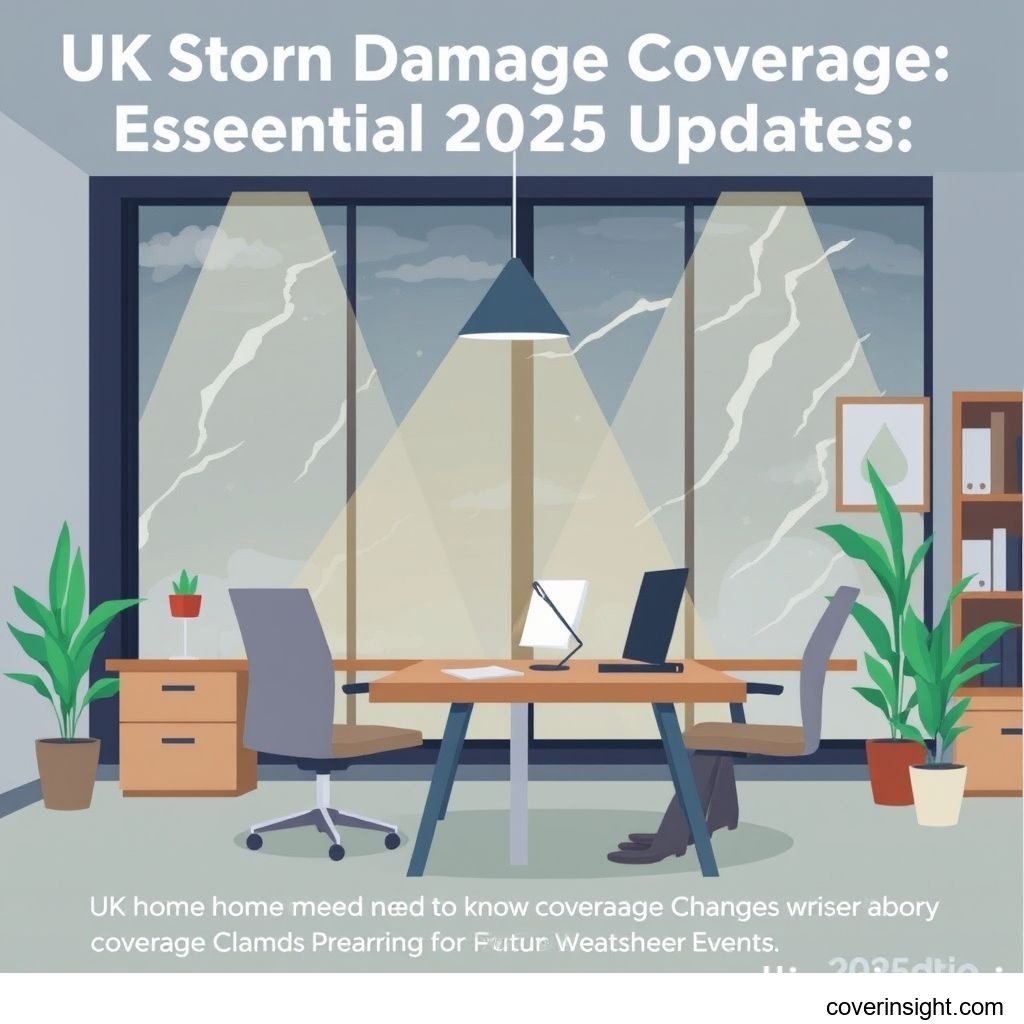UK Storm Damage Coverage: Essential 2025 Updates
Introduction
The British Isles, with its famously unpredictable weather, is no stranger to the fierce embrace of winter storms and the occasional summer deluge. As we look towards 2025, understanding your home insurance coverage for storm damage is more crucial than ever. The insurance landscape, particularly in Great Britain, has been subtly yet significantly shaped by the broader implications of global events. While storm damage directly relates to meteorological phenomena, the post-pandemic era has brought about a renewed focus on risk assessment, supply chain resilience, and the overall cost of claims, which indirectly impacts the scope and pricing of traditional coverage. These pandemic coverage updates in GB (2025), though not directly about viruses and vaccines, reflect an industry adapting to new economic realities and a heightened awareness of unforeseen disruptions, making it vital for homeowners to review their policies.
Coverage Details
Navigating the nuances of insurance policies can feel like a labyrinth, but knowing what's typically covered and what isn't can save you a world of hurt when the gales blow.
What’s Included
Generally, a standard home insurance policy in the UK covers damage to your property caused by storms. This typically includes:
-
Structural Damage: Harm to your roof, walls, and foundations from high winds, hail, or falling trees. Think of a chimney stack taking a tumble or tiles being ripped away – that's usually covered.
-
Water Ingress: If heavy rain, driven by wind, forces its way through damaged parts of your roof or walls, leading to internal water damage, this is often included. However, note the caveat below regarding gradual ingress.
-
Fallen Objects: Damage from trees, lamp posts, or other debris blown onto your property by storm-force winds.
-
Outbuildings: Garages, sheds, and conservatories are usually covered if they are part of your main home policy.
-
Alternative Accommodation: If your home becomes uninhabitable due to storm damage, your policy might cover the cost of temporary accommodation while repairs are underway.
Common Exclusions
While policies aim to provide peace of mind, there are common exclusions you should be aware of, lest you get caught out:
-
Wear and Tear: Insurance isn't a maintenance contract. Gradual deterioration, rot, or corrosion are not covered. If your roof was already past its best and simply gave up the ghost in high winds, you might struggle with a claim.
-
Gradual Damage/Ingress: Damage from rain or water that seeps in over time due to poor maintenance or pre-existing defects, rather than a sudden event, is typically excluded. For instance, a leaky window seal that's been dripping for months won't be covered under 'storm damage'.
-
Fences and Gates: While some policies cover these, many exclude them due to their susceptibility to wind damage. It's often considered "comes with the territory" for garden boundaries. Always check your specific policy wording.
-
Coastal Erosion: If your property is damaged by the sea, unless it’s directly linked to an insured storm event, it might fall under a specific exclusion for coastal erosion or landslip.
-
Flood from Rivers/Sea: While surface water flooding (from heavy rain) is often covered, flooding from rivers or the sea can be a specific exclusion or require a specialist flood endorsement. A stark reminder of this was the impact of Storm Arwen in 2021, which saw widespread power cuts and property damage across the UK, putting many policies to the test. Insurers like Aviva and Direct Line reported significant claims volumes, highlighting the difference between wind damage and specific flood events.
Cost Analysis
Understanding the factors that influence your premium for storm damage coverage, and how to potentially trim those costs, is always a savvy move. For more in-depth knowledge, consider exploring various Insurance Resources Global.
Price Factors
Several elements play a role in how much you'll pay for your storm damage coverage:
-
Location: Properties in areas prone to higher winds, coastal regions, or known flood plains will inevitably face higher premiums. For example, homes in exposed parts of Scotland or the West Country might pay more than those in sheltered inland areas.
-
Property Type and Age: Older homes, particularly those with less robust roofing materials or unique architectural features, can be more susceptible to storm damage and thus more expensive to insure.
-
Claims History: A history of previous claims, whether by you or previous occupants, can push up costs.
-
Sum Insured: The higher the rebuild cost of your home, the more you’ll pay. It's vital to ensure this figure is accurate, not just the market value, to avoid underinsurance.
-
Excess: A higher voluntary excess (the amount you pay towards a claim) typically leads to a lower premium.
-
Security Measures: Robust locks, alarm systems, and even smart home security can sometimes lead to slight reductions, as they demonstrate a proactive approach to risk management.
Saving Tips
It’s not just about keeping a stiff upper lip; you can actively reduce your premiums:
-
Increase Your Excess: If you're comfortable paying a larger sum if you make a claim, increasing your voluntary excess can significantly lower your annual premium.
-
Improve Home Security: As mentioned, good security can sometimes help.
-
Shop Around: Don’t just renew automatically. Use comparison websites or speak to a broker. Different insurers have different risk appetites. When looking at options, remember to check out GB Insurance Home for localised comparison tools.
-
Combine Policies: Insuring your home and contents with the same provider can often secure a discount.
-
Maintain Your Property: While not directly affecting premiums, a well-maintained home is less likely to suffer severe storm damage, reducing the need to claim and protecting your no-claims discount. The Association of British Insurers often publishes guidance on home maintenance to mitigate risks.
FAQs
-
How much does pandemic coverage updates cost?
This question is a bit of a curveball as "pandemic coverage updates" aren't a direct add-on cost in the same way flood cover might be. Rather, the broader impact of the pandemic on global supply chains, labour costs, and risk assessment has indirectly influenced the general increase in insurance premiums across the board for 2025. Insurers are factoring in higher repair costs and potential delays for materials and tradespeople. So, while you won't see a line item for 'pandemic updates', its ripple effect is certainly felt in overall premium adjustments for standard coverages like storm damage.
-
What affects premiums?
As detailed above, key factors include your geographical location (e.g., proximity to coastal areas or flood plains), the age and construction of your property, your claims history, and the level of cover you choose (including your excess). Market conditions, influenced by the broader economic climate, also play a significant role.
-
Is it mandatory?
While home insurance itself isn't legally mandatory in the UK, if you have a mortgage, your lender will almost certainly require you to have buildings insurance in place to protect their investment. Contents insurance is optional but highly recommended for protecting your belongings.
-
How to choose?
Start by assessing your needs – what’s the rebuild cost of your home? What are your belongings worth? Then, compare policies from multiple providers, paying close attention to the small print, especially regarding storm and flood exclusions. Check customer reviews and the insurer’s claims handling reputation. The Financial Conduct Authority provides guidance on choosing financial products responsibly.
-
Consequences of no coverage?
Without adequate coverage, you'd be entirely responsible for the often astronomical costs of repairing storm damage to your property, replacing damaged contents, and finding alternative accommodation. This could lead to severe financial hardship, potentially even bankruptcy. It’s simply not worth the risk.
Author Insight & Experience: As someone living in GB, I've seen first-hand the shift in weather patterns and the increasing intensity of storms. It’s not just about a bit of drizzle; we're talking about legitimate challenges to our homes. Based on my experience, the biggest mistake people make isn't refusing insurance, but neglecting to properly review their policy each year. That little notification from your insurer often contains crucial updates or changes in terms that can profoundly affect your coverage. A quick check of the fine print and a comparison shop could be the difference between a minor inconvenience and a major headache when the next storm rolls in. It’s a bit like preparing for a rainy day – you hope you won't need the umbrella, but you'll be chuffed to bits when you have it.







Comments